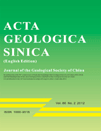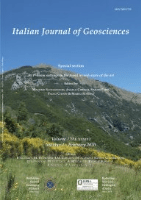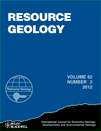
Visnyk of Taras Shevchenko National University of Kyiv-Geology
Scope & Guideline
Illuminating the Path of Geological Discovery and Innovation
Introduction
Aims and Scopes
- Geological Research and Assessments:
The journal focuses on comprehensive geological studies including mineral deposits, hydrocarbon potential, and geological mapping, providing crucial insights into the resource base of Ukraine. - Geophysical Investigations:
It emphasizes the application of innovative geophysical methods such as seismic, magnetic, and gravimetric studies to assess geological formations and predict geological hazards. - Environmental Geology and Ecological Monitoring:
Research related to the environmental impacts of geological activities, pollution assessments, and the monitoring of natural resources forms a core area of focus, particularly in the context of Ukraine's recovery and ecological safety. - Technological Innovations in Geology:
The journal publishes papers on new methodologies and technologies in geology, including the use of remote sensing, GIS, and machine learning applications in geological research. - Resource Management and Policy Implications:
Research discussing regulatory frameworks, resource management strategies, and the socio-economic implications of geological exploration and exploitation is also a significant component of the journal.
Trending and Emerging
- Impact of War on Geology:
With the ongoing conflict in Ukraine, there is an increasing focus on the effects of war on geological resources, infrastructure, and environmental stability, positioning the journal as a critical resource for understanding these challenges. - Climate Change and Environmental Geology:
Research addressing the impacts of climate change on geological processes, resource management, and environmental safety is becoming increasingly prominent, highlighting the need for adaptive strategies in geological studies. - Innovative Data Analysis Techniques:
The use of advanced data analysis techniques, including machine learning and AI in geological modeling and prediction, is emerging as a significant trend, reflecting the integration of technology in geological research. - Sustainable Resource Management:
There is a growing emphasis on sustainable practices in mineral extraction and environmental management, aligning with global sustainability goals and the need for responsible resource utilization. - Geohazards and Risk Assessment:
An increase in research focused on geohazards, including landslides, earthquakes, and their socio-economic impacts, is evident, indicating a shift towards understanding and mitigating geological risks.
Declining or Waning
- Traditional Geological Studies:
Papers focusing exclusively on traditional geological mapping and classification without integrating modern technology or addressing contemporary issues are becoming less frequent. - Historical Geological Research:
There has been a noticeable decrease in studies focused on historical geology or paleogeography, as the journal shifts towards more applied and contemporary geological challenges. - Local Geological Case Studies:
Research centered on very localized geological phenomena, without broader implications or connections to larger geological processes, appears to be waning in favor of studies with wider relevance.
Similar Journals

Spisanie Na B Lgarskoto Geologichesko Druzhestov-Review of the Bulgarian Geological Society
Fostering collaboration in the pursuit of geological excellence.Spisanie Na B Lgarskoto Geologichesko Druzhestov-Review of the Bulgarian Geological Society, published by the BULGARIAN ACADEMY OF SCIENCE, serves as a leading platform for the dissemination of pioneering research and comprehensive reviews in the field of geology. With the ISSN 0007-3938 and E-ISSN 1314-8680, this esteemed journal underlines its commitment to advancing geological sciences, particularly pertinent to the Bulgarian context but with broader implications for global studies. While the journal does not currently offer open access options, its rigorous peer-review process ensures high-quality publications that enrich the geological literature. The journal aims to bridge the gap between theory and empirical research, fostering collaboration among researchers, professionals, and students. With its strategic location in Sofia, Bulgaria, it stands as a vital resource for those keen on exploring the complexities of Earth sciences and contributes significantly to the prestige of the Bulgarian geoscience community.

ACTA GEOLOGICA SINICA-ENGLISH EDITION
Pioneering Discoveries in Geology and BeyondACTA GEOLOGICA SINICA-ENGLISH EDITION is a distinguished academic journal published by Wiley, providing a platform for cutting-edge research in the field of geology. With an ISSN of 1000-9515 and E-ISSN 1755-6724, this journal has been a pivotal resource since its inception in 1988, catering to scholars and professionals until 2024. The journal is recognized for its high-quality articles, achieving a Q2 ranking in the field of Geology according to the 2023 category quartiles, and ranks #122 out of 321 in the Scopus Earth and Planetary Sciences sector, placing it within the 62nd percentile among its peers. Although currently not available as an open access publication, it remains a significant repository of knowledge that supports ongoing geological research and exploration. For researchers, students, and professionals looking to deepen their understanding of geological sciences, ACTA GEOLOGICA SINICA-ENGLISH EDITION stands as an essential journal, promoting collaboration and innovation in the earth sciences.

GEOLOGIA CROATICA
Championing Open Access in Earth SciencesGEOLOGIA CROATICA is a distinguished open-access journal published by the Croatian Geological Survey, dedicated to advancing the field of Earth and planetary sciences. Since its inception in 1992, this peer-reviewed journal has become an essential resource for researchers, professionals, and students interested in various aspects of geology. With its robust impact factor and a prestigious place in Scopus rankings, ranking 127th out of 321 in Geology and 77th out of 159 in miscellaneous Earth and Planetary Sciences as of 2023, GEOLOGIA CROATICA maintains a strong international presence. It provides a platform for the dissemination of critical research findings, promoting collaboration and knowledge sharing among the global scientific community. By focusing on high-quality manuscripts that cover geological processes, hazards, and resources, this journal is pivotal for anyone looking to contribute to or expand their understanding of geological sciences. The journal's commitment to open access ensures that invaluable research is accessible to all, fostering a more informed and scientifically engaged society.

REVISTA DE LA SOCIEDAD GEOLOGICA DE ESPANA
Bridging Research and Practice in the GeosciencesREVISTA DE LA SOCIEDAD GEOLOGICA DE ESPANA, published by the SOCIEDAD GEOLOGICA DE ESPAÑA, FACULTAD DE CIENCIAS, serves as a pivotal platform for the dissemination of cutting-edge research in the field of geology. With its roots planted firmly in Spain, this journal focuses on advancing the understanding of geological processes and Earth sciences, making it an essential resource for researchers, professionals, and students in the discipline. Despite currently being classified in the Q4 category of Geology, the journal has the potential to evolve as it continues to publish high-quality scholarly articles, fostering dialogue and collaboration within the geological community. Although it operates without an open-access model, the journal ensures wide accessibility to its content through various academic databases. As it enters the converged publication phase from 2016 to 2024, REVISTA DE LA SOCIEDAD GEOLOGICA DE ESPANA remains committed to providing innovative insights and valuable contributions to the scientific body of knowledge in geology.

Geofizicheskiy Zhurnal-Geophysical Journal
Bridging Theory and Practice in Geophysical ScienceGeofizicheskiy Zhurnal-Geophysical Journal, published by the esteemed S I Subbotin Institute of Geophysics, National Academy of Sciences of Ukraine, stands as a vital resource for professionals and researchers in the field of geophysics. With an ISSN of 0203-3100 and an E-ISSN of 2524-1052, this journal is recognized for its rigorous peer-reviewed articles that delve into various aspects of geophysical research, including seismic studies, geodynamics, and Earth surface processes. Although currently not under an open access model, the journal maintains a commitment to disseminating high-quality research, thereby enriching the global geophysical community. The publication aims to foster collaboration and knowledge transfer among scientists and engineers while addressing complex geophysical challenges in a rapidly evolving landscape. By engaging with cutting-edge research, readers can expect to uncover insights that advance both theoretical understanding and practical applications in geophysical science.

Vestnik of Saint Petersburg University Earth Sciences
Innovative Research, Global ImpactVestnik of Saint Petersburg University Earth Sciences, published by ST PETERSBURG UNIV PRESS, serves as a pivotal platform for the dissemination of innovative research within the fields of Earth Sciences, Environmental Science, Geography, and Geology. This journal, with an ISSN of 2541-9668 and an E-ISSN of 2587-585X, aims to foster scholarly communication and facilitate advancements in understanding the diverse and complex interactions within our planet's systems. Operating from the Russian Federation, the journal is unique in its commitment to an open-access model, making critical research accessible to a global audience of researchers, professionals, and students. Although currently classified in the Q4 quartile in several relevant categories, its ranking showcases the potential for growth and increased impact within the academic community. Aiming to converge ideas and findings from 2017 to 2024, the Vestnik of Saint Petersburg University Earth Sciences is dedicated to enriching the dialogue and supporting collaborative research efforts in disciplines crucial for sustainable development and environmental stewardship.

Italian Journal of Geosciences
Connecting Scholars: A Gateway to Earth and Planetary SciencesItalian Journal of Geosciences, published by the Società Geologica Italiana, is a distinguished platform for the dissemination of research in the fields of Earth and Planetary Sciences and Geology. With an impressive impact factor reflected in its 2023 rankings, where it placed in the Q3 category across its related fields, this journal serves as a vital resource for academics, practitioners, and students. Established in 2010 and poised to continue until 2024, the journal showcases critical advancements and interdisciplinary studies that deepen our understanding of geological processes and Earth systems. Operating under open access options, it offers robust accessibility to a broad audience, facilitating wider dissemination of knowledge. The journal's affiliation with Università degli Studi La Sapienza in Rome, Italy, further underscores its commitment to academic excellence and innovation in geosciences.

Turkiye Jeoloji Bulteni-Geological Bulletin of Turkey
Connecting innovative geological theories with real-world applications.Turkiye Jeoloji Bulteni-Geological Bulletin of Turkey (ISSN: 1016-9164) is a prominent scholarly journal published by the TMMOB JEOLOJI MUHENDISLERI ODASI in Türkiye, dedicated to advancing the field of geology through high-quality research and dissemination of significant scientific findings. With an emphasis on geological studies pertinent to the region and its global implications, the journal serves as a crucial platform for researchers, professionals, and students aiming to share and explore innovative theories, methodologies, and case studies. Although the journal operates under a traditional access model, its rich content provides valuable insights into varied topics including but not limited to mineralogy, geophysics, petrology, and environmental geology. Furthermore, the journal's commitment to exhibiting originality and relevance ensures its vital role in shaping geological research, fostering collaboration among academics and practitioners alike.

RESOURCE GEOLOGY
Advancing Knowledge in Geology and Resource ManagementRESOURCE GEOLOGY, published by WILEY, is a peer-reviewed journal that serves as a vital platform for the dissemination of innovative research in the fields of geology and geochemistry. With an ISSN of 1344-1698 and e-ISSN 1751-3928, the journal has steadily contributed to the academic community since its inception in 1996, continuing through its planned convergence in 2024. With a Q3 ranking in both Geochemistry and Petrology and Geology categories, RESOURCE GEOLOGY is positioned within the competitive landscape of Earth and Planetary Sciences, ranked 164th and 93rd in its respective categories on Scopus, reflecting its significant contribution to the body of knowledge in these fields. While not an open-access journal, it provides access to essential research that advances our understanding of natural resources and geological processes. The journal is dedicated to publishing high-quality articles that appeal to researchers, professionals, and students looking to deepen their insight into the intricate interplay between geological phenomena and resource management.

Journal of Himalayan Earth Sciences
Advancing Knowledge in Himalayan Earth SciencesThe Journal of Himalayan Earth Sciences (ISSN: 1994-3237; E-ISSN: 2305-6959) is a distinguished publication by UNIV PESHAWAR, dedicated to advancing knowledge in the field of earth sciences, particularly as they relate to the Himalayan region. Established in 2013, this journal aims to provide a platform for researchers, professionals, and students to share original research findings, reviews, and innovative methodologies that contribute to the understanding of geological and environmental phenomena in this ecologically significant area. Despite being categorized in Q4 of the Earth and Planetary Sciences, the journal showcases valuable contributions to the scientific community and encourages submissions that delve into both the challenges and advancements within Earth sciences, with a particular focus on the unique geological structures and processes of the Himalayas. As an open-access journal, it ensures that research is accessible to a global readership, promoting collaboration and discussion among scholars and practitioners. The journal's operational base in Peshawar, Pakistan, places it at the heart of Himalayan research, making it an invaluable resource for those invested in earth sciences.